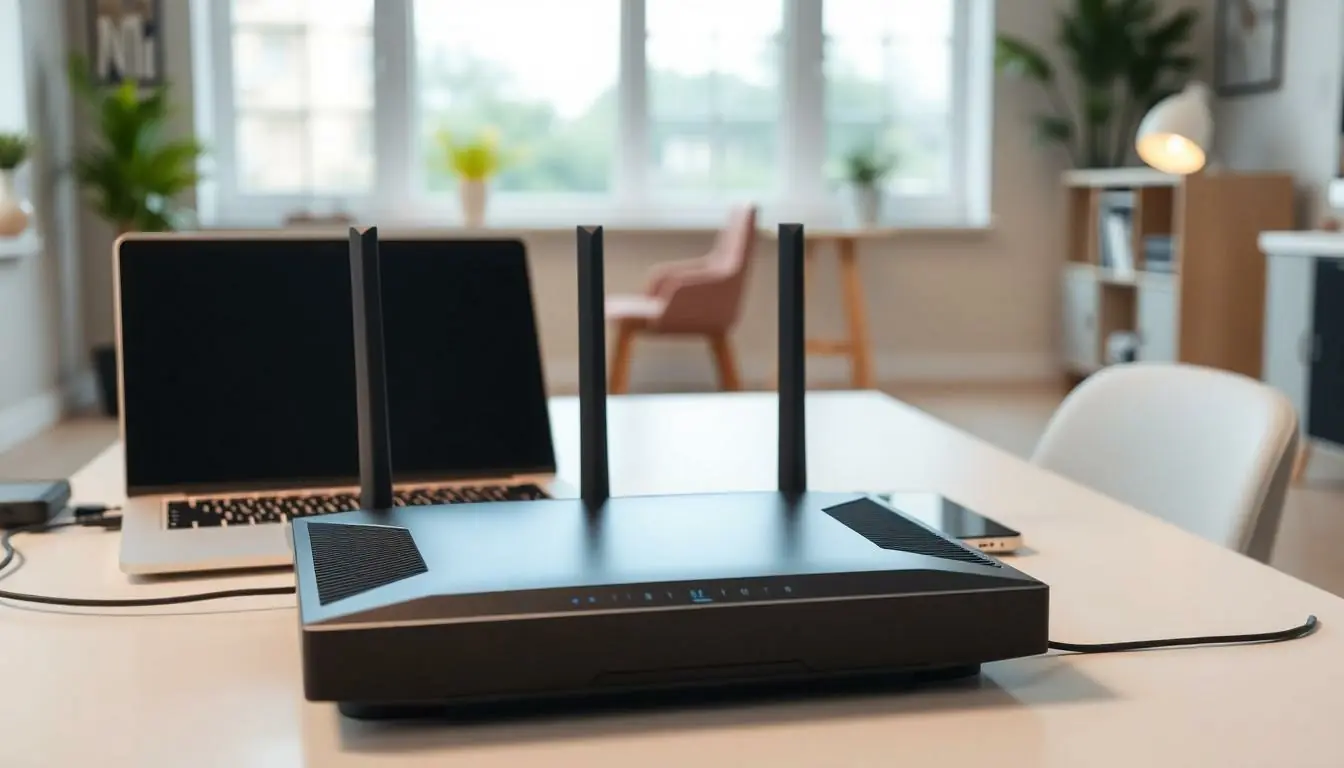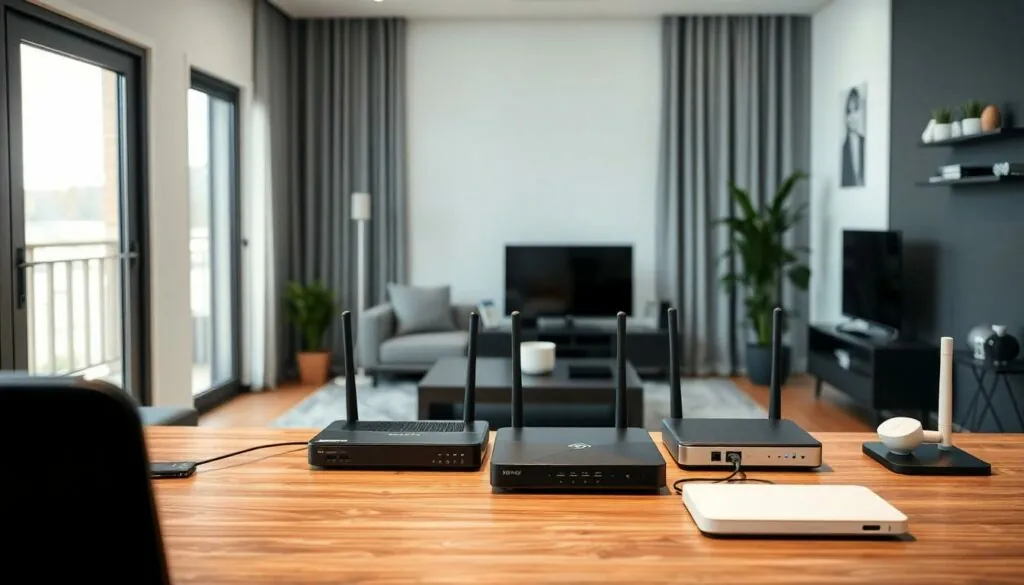Table of Contents
ToggleIn today’s world, a reliable home network is as essential as coffee on a Monday morning. Whether streaming the latest binge-worthy series or battling it out in an online gaming tournament, having the right networking equipment can make or break the experience. Imagine buffering so long that you forget what you were watching—no one wants that kind of drama.
Overview of Home Networking Equipment
Home networking equipment consists of several essential devices that ensure reliable connectivity. Routers connect to the internet service provider, distributing the connection to various devices throughout the home. Modems, often bundled with routers, facilitate access to the internet by converting signals between the service provider and the household.
Switches expand network capacity by allowing additional wired devices to connect efficiently. Access points enhance wireless coverage, especially in larger homes, by extending Wi-Fi signals to reach dead zones. Network extenders also improve coverage, amplifying existing signals to eliminate weak areas.
Choosing the right equipment depends on network demands. Devices used for streaming frequently require higher bandwidth. Online gaming setups benefit from low-latency equipment to minimize lag, while smart home devices usually operate seamlessly with stable connections.
Security features are crucial for protecting personal data. Many routers now incorporate firewalls and encryption standards like WPA3, safeguarding network integrity. Regular software updates for these devices further strengthen security and ensure optimal performance.
Some setups may involve mesh networks, which consist of multiple devices working together to provide expansive coverage across the home. These systems allow seamless transitions between access points, maintaining a stable connection as users move throughout their spaces.
Evaluating individual needs helps in selecting appropriate networking equipment. By understanding traffic demands and usage patterns, individuals can optimize their home networks for reliable connectivity and performance.
Types of Home Networking Equipment

Understanding different types of home networking equipment is essential for establishing a reliable home network. Each component plays a critical role in functionality and performance.
Routers
Routers act as the central hub in a home network. They connect to internet service providers and distribute internet access to devices throughout the household. Many modern routers incorporate advanced features like Quality of Service (QoS), prioritizing bandwidth for specific activities like streaming or gaming. Routers can support both wired and wireless connections, making them versatile. They include built-in security features, such as firewalls and encryption protocols, which protect users from potential threats.
Modems
Modems function as the bridge between the internet service provider and home devices. They receive signals from the ISP and convert them into usable data. Different types of modems exist, including DSL, cable, and fiber-optic models, each suited to specific internet plans. Selecting the right modem ensures optimal compatibility with network requirements and speeds. Many equipment packages combine modems and routers in a single device for simplicity, but separate devices can offer enhanced performance.
Access Points
Access points boost Wi-Fi coverage in larger homes, connecting wirelessly to the router. They extend the range of an existing network, reaching areas that a single router may not cover. With multiple devices connected, access points maintain strong signals, eliminating dead zones. Businesses also utilize access points, but they’re invaluable for ensuring robust home networking. Some access points support advanced features, including dual-band technology, allowing better management of multiple devices.
Factors to Consider When Choosing Home Networking Equipment
Choosing the right home networking equipment involves several crucial factors that impact overall connectivity and performance.
Speed and Performance
Speed significantly affects user experience. Bandwidth requirements vary, especially for streaming and gaming. A router with at least AC1200 standard offers adequate performance for most households. Devices requiring high definition streaming necessitate faster connections. Online gaming setups benefit from low-latency equipment to minimize lag. Incorporating features like Quality of Service enhances performance by prioritizing bandwidth for critical applications.
Range and Coverage
Range determines the area in which devices can access the network. A strong Wi-Fi signal reaches all corners of the home, eliminating dead zones. For larger residences, a mesh network offers seamless coverage, utilizing multiple access points. Users should assess square footage to choose equipment with sufficient range. Devices that support dual-band frequencies can enhance coverage, allowing connections to both 2.4GHz and 5GHz bands.
Security Features
Security plays a vital role in protecting personal data from unauthorized access. Look for equipment supporting WPA3 encryption, which provides enhanced protection over previous standards. Built-in firewalls also safeguard home networks from external threats. Regular software updates ensure ongoing security against evolving vulnerabilities. Choosing devices with advanced security features promotes a safe online environment for all connected devices.
Top Brands for Home Networking Equipment
Several brands stand out in the home networking equipment market. These brands offer reliable products that cater to diverse connectivity needs, ensuring smooth internet experiences.
Netgear
Netgear leads in performance, offering a range of routers known for high-speed capabilities. The Nighthawk series stands out, supporting streaming and gaming with features like QoS. Mesh Wi-Fi systems, such as Orbi, expand coverage throughout large homes. Enhanced security features, including WPA3 encryption, add an extra layer of protection. Reliable customer support facilitates effortless setup and troubleshooting.
TP-Link
TP-Link provides versatile networking solutions, including routers, extenders, and switches. The Archer series excels in speed, accommodating multiple devices without lag. Deco mesh systems enhance coverage, eliminating dead zones effectively. User-friendly interfaces streamline configuration for all skill levels. Additionally, built-in security protocols ensure safe connectivity in smart homes.
ASUS
ASUS has a reputation for feature-rich devices that cater to gamers and digital enthusiasts. Known for robust performance, the RT-AX series supports the latest Wi-Fi 6 technology, delivering faster speeds and low latency. Innovative security features protect users from online threats. Customizable settings enable advanced users to fine-tune performance. Mesh networking options further enhance coverage across larger spaces.
Investing in the right home networking equipment is essential for navigating today’s digital landscape. A reliable network enhances streaming experiences and supports online gaming while ensuring smart home devices operate seamlessly.
By prioritizing features like speed range and security, individuals can tailor their setups to meet specific needs. Brands like Netgear TP-Link and ASUS offer a variety of options designed for different requirements.
Ultimately a well-thought-out home network not only improves connectivity but also safeguards personal data. As technology continues to evolve staying informed about equipment choices will empower users to create efficient and secure home networks.





